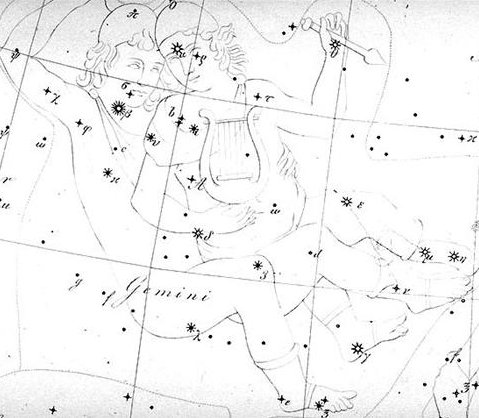Wasat (the star in the Middle) was at
the Full Moon in January 6 - i.e. 184 days after
July 6 when Wezen rose with the Sun:
 |
 |
|
 |
 |
 |
|
Ga8-22 |
Ga8-23 |
Ga8-24 (227) |
Ga8-25 |
Ga8-26 |
|
NOVEMBER 1 |
2 (306) |
3 |
4 |
5 |
|
19h (289.2) |
Al Baldah-19 |
Aladfar (291.1), Nodus II (291.5), ψ
Sagittarii (291.6), θ Lyrae (291.8) |
ω Aquilae (292.1), ρ Sagittarii (292.6), υ
Sagittarii (292.7) |
Arkab Prior (293.0), Arkab Posterior, Alrami
(293.2),
χ Sagittarii
(293.6) |
|
λ Aquilae (Ant.) (289.1), γ Cor. Austr
(289.3),
τ Sagittarii
(289.4), ι Lyrae (289.5), δ Cor. Austr.
(289.8) |
AL BALDAH,
Alphekka Meridiana (290.1), β Cor. Austr.
(290.2) |
|
January 4 |
5 (370) |
6 |
7 |
8 |
|
NAKSHATRA DATES: |
|
MAY 3 (123) |
4 |
|
5 |
6 |
7 (492) |
|
WEZEN (107.1),
τ Gemini (107.7), δ Monocerotis (107.9) |
no star listed
(108) |
λ Gemini
(109.4), Wasat (109.8) |
no star listed
(110) |
Aludra (111.1),
Propus (111.4), Gomeisa (111.6) |
|
July 6 |
7 |
8 |
9 (190) |
10 |
With 370 days
for a cycle (instead of our 365) there should be a
hanau glyph here (Ga8-24). The C tablet
carries 740 = 2 * 370 glyphs. In Ga8-25 we can see a
pair of united twin figures with a dark earth rising
in front of the less perfect of them.
...
Wasat ('the Middle',
δ
Gemini) was close to the ecliptic and it may have
represented the navel of Pollux.

 |
|
 |
 |
 |
 |
|
Gb1-1 (230) |
Gb1-2 |
Gb1-3 |
Gb1-4 |
Gb1-5 |
|
NOVEMBER 6 (310) |
7 |
8 |
9 |
π |
|
Deneb Okab (294.0), α Vulpeculae (294.9) |
ν Aquilae (Ant.) (295.0), Albireo (295.5) |
μ Aquilae (296.3), ι Aquilae (Ant.) (296.8),
κ Aquilae (Ant.) (296.9) |
ε Sagittae (297.1), σ Aquilae (Ant.)
(297.4), Sham (297.8) |
β Sagittae (298.0), χ Aquilae (298.3), ψ
Aquilae (298.8) |
|
January 9 |
10 |
11 |
12 |
378 |
|
NAKSHATRA DATES: |
|
MAY
8 (493) |
|
9 |
10 (130) |
11 |
12 |
|
Ghost-23 |
Al Dhirā'-5 /
Punarvasu-7 |
ANA-TAHUA-VAHINE-O-TOA-TE-MANAVA |
α Monocerotis
(115.4), σ Gemini (115.7) |
Mash-mashu-arkū-12 |
|
ρ GEMINI
(112.1),
Eskimo Nebula (112.2)
Antares
|
CASTOR
(113.4) |
υ Gemini
(114.0), Markab Puppis (114.7),ο Gemini
(114.8), PROCYON
(114.9) |
κ Gemini
(116.1), POLLUX
(116.2), π Gemini (116.9) |
|
July 11 |
12 (193) |
13 |
14 |
15 |
 |
 |
 |
|
Gb1-6 (235) |
Gb1-7 |
Gb1-8 |
|
NOVEMBER 11 |
12 (316) |
13 |
|
υ Aquilae (299.1),
Tarazed
(299.3), δ Sagittae (299.6), π Aquilae
(299.9) |
Sravana-23 |
ι Sagittarii (301.2), Terebellum, ξ Aquilae
(301.3),
Alshain
(301.6), φ Aquilae (301.8) |
|
ζ Sagittae (300.1),
ALTAIR
(300.3), ο Aquilae (300.5), Bezek (300.8) |
|
January
14 |
15 (380) |
16 |
|
NAKSHATRA DATES: |
|
MAY
13 (133) |
14 (499) |
15 (135) |
|
Azmidiske
(117.4) |
φ Gemini (118.4) |
Drus (119.9) |
|
July 16 |
17 (198) |
18 (564) |
At Gb1-8 was nakshatra Drus (χ at the root
of the 'tree' of the Ship), where MAY 15 could
have alluded to May 15 (135) when Tau-ono rose with
the Sun.
.jpg)
|
Egyptian sticks |
 |
Phoenician
taw |
 |
Greek chi |
Χ (χ) |
|
Greek tau |
Τ (τ) |
|
In
Plato's Timaeus, it is explained
that the two bands that form the soul of
the world cross each other like the
letter Χ.

Chi or X
is often used to abbreviate the name
Christ, as in the holiday Christmas
(Xmas). When fused within a single
typespace with the Greek letter Rho, it
is called the labarum and used to
represent the person of Jesus Christ.
(Wikipedia)

...
tau is the 19th letter of the Greek
alphabet. In the system of Greek
numerals it has a value of 300 ...
Taw is believed to be derived from
the Egyptian hieroglyph meaning 'mark'
...
Taw,
Tav or Taf is the
twenty-second and last letter in many
Semitic abjads ... In gematria Tav
represents the number 400, the largest
single number that can be represented
without using the Sophit forms ...
'From
Aleph to Taf' describes
something from beginning to end; the
Hebrew equivalent of the English 'From A
to Z' ...
Tav
is the last letter of the Hebrew word
emet, which means truth. The midrash
explains that emet is made up of
the first, middle, and last letters of
the Hebrew alphabet (Aleph,
Mem, and Tav...).
Sheqer (falsehood), on the other
hand, is made up of the 19th, 20th, and
21st (and penultimate) letters.
Thus,
truth is all-encompassing, while
falsehood is narrow and deceiving. In
Jewish mythology it was the word emet
that was carved into the head of the
Golem which ultimately gave it life.
But when the letter 'aleph' was erased
from the Golem's forehead, what
was left was 'met' - dead. And so
the Golem died ... (Wikipedia)

|
|












.jpg)


